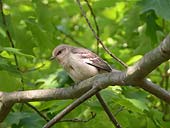
|
|
Download Options
| Image Name | Width x Height | Size |
|---|---|---|
| SIA0068.jpg | 640 x 498 | 48K |
| SIA0068.jpg | 1200 x 933 | 129K |
| SIA0068.jpg | 2560 x 1990 | 362K |
Caption
The Mockingbird is well named as it mocks or mimics the sounds of other birds. It may not only reproduce phrases borrowed from as many as twenty birds in its neighborhood but also the barking of a dog, the cackling of a hen, the squeal of a pig, or even the squeaking of a wagon wheel. The length of the phrase may vary from a single note, such as the caw of a crow, to the song of a robin.
The mockingbird is about the size of a robin except that it is more slender and has a longer tail. Both sexes have brownish-gray backs, are whitish or grayish below and, on the wings and tail, have large white markings which are especially conspicuous in flight. It is abundant in the southern states, and is the official bird of Florida, Tennessee, Mississippi, Arkansas and Texas. It prefers open areas with a few trees and dense shrubbery, near towns and farms, where the male pugnaciously defends a territory against cats, snakes, hawks and other birds. The bulky nest of sticks, weeds and trash, vined with rootlets, horsehair and cotton, is built in a shrub or small tree and in it are laid from 3 to 5 eggs -- greenish, buffy or blue; blotched with brown or purplish spots. Frequently, three broods are reared in a season .
In addition to music borrowed from other birds, often interrupted by harsh grating calls, the male is famous for his rapturous mating song which is a gurgling series of sweet liquid notes, sung not only in daytime but throughout moonlight nights. In spring and early summer they feed largely upon insects, including many injurious kinds. Later, their food is largely berries, seeds and wild fruits.